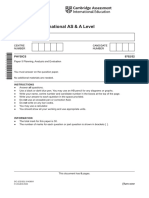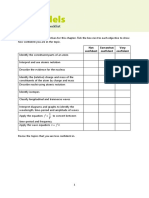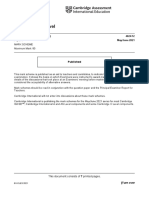Physics Lab Report Format
Uploaded by
jamesPhysics Lab Report Format
Uploaded by
jamesPhysics Lab Report Format
Lab Report Format General Remarks: Part of your lab experience should be learning how to
organize and present your work in a scientific way. Any lab report should have the following
features:
It should be concise but should also contain the necessary details and well developed
explanations.
It should be organized. You should enable the reader to quickly find the information he or she
may be interested in.
It should contain all the relevant information and reasoning. You should enable the reader to
validate your conclusion. A possible way to achieve this is using the following framework:
Objective: State what you want to achieve in this experiment. A formal way to do this is
to state a question or hypothesis that you want to address. This should be the scientific goal of
the experiment, not the educational goal (though you should understand that too). One or two
well thought out sentences is all that you should need for this.
Method: You should include a summary of the lab procedure in your words; do not
merely copy what is in the manual. This section should demonstrate your understanding of
exactly what you measured, how you measured it, and why this measurement helps you answer
the question you posed in the objective section. You dont need to detail each step of math that
you will do in the analysis, just what your general approach will be for getting your raw data to
answer the question you are interested in. This section should not be more than about half a page.
Data: In this section you should include the raw data you measured. Be sure to present
your data in an organized manner (e.g. a data table) and to include units.
Data and Error Analysis: In this section you will manipulate the data in order to help
you address your question or hypothesis. Usually this entails performing calculations and/or
creating graphs of the data. You cannot draw any final conclusions from your data until you
think carefully about how well you can trust your data and what factors may have affected or
biased it.
Conclusion: Finally, after all this work, go back and answer the question you stated in
the beginning. Does your data allow you to support or reject your hypothesis, or is the data
inconclusive? Also do you have anything you can compare your results with (e.g. a value in the
literature, a second measurement, a measurement with a different method, other lab groups)?
How well does it compare to such a value?
You might also like
- 4.4.6 Force On A Current-Carrying ConductorNo ratings yet4.4.6 Force On A Current-Carrying Conductor4 pages
- Physics P1 Topical Past Papers-Selected-249-294No ratings yetPhysics P1 Topical Past Papers-Selected-249-29447 pages
- New - IBDP - Physics - Syllabus - Student VersionNo ratings yetNew - IBDP - Physics - Syllabus - Student Version24 pages
- Open Lab Investigating: Subject: PhysicsNo ratings yetOpen Lab Investigating: Subject: Physics7 pages
- Cambridge Learner Guide For As and A Level PhysicsNo ratings yetCambridge Learner Guide For As and A Level Physics4 pages
- 5 3 Internal Resistance of A Battery LabNo ratings yet5 3 Internal Resistance of A Battery Lab2 pages
- physics papers (for 2023 syllabus) - V2No ratings yetphysics papers (for 2023 syllabus) - V242 pages
- Philippine Physics Olympiad 2024 Qualifying Round Examination Question BookletNo ratings yetPhilippine Physics Olympiad 2024 Qualifying Round Examination Question Booklet12 pages
- Solving Equations - Word Problems (Green, Blue, Black)No ratings yetSolving Equations - Word Problems (Green, Blue, Black)10 pages
- CIE Igcse Physics Paper 2 Practice Tests 20 Sample PagesNo ratings yetCIE Igcse Physics Paper 2 Practice Tests 20 Sample Pages105 pages
- Physics 9702 Paper 5 Skill Breakdown of MarksNo ratings yetPhysics 9702 Paper 5 Skill Breakdown of Marks12 pages
- Cambridge International AS & A Level: PHYSICS 9702/22No ratings yetCambridge International AS & A Level: PHYSICS 9702/2216 pages
- Fundamental Physics - Oup - Com.pk Download (252 Pages - Free)No ratings yetFundamental Physics - Oup - Com.pk Download (252 Pages - Free)2 pages
- Physical Quantities and Uncertainty - WorksheetNo ratings yetPhysical Quantities and Uncertainty - Worksheet26 pages
- Criterion - B - C - Checklist FOR IB SCIENCESNo ratings yetCriterion - B - C - Checklist FOR IB SCIENCES3 pages
- Cambridge O Level Physics Practical Electricity: Danger of ElectricityNo ratings yetCambridge O Level Physics Practical Electricity: Danger of Electricity5 pages
- Chapter 01 Physical Quantities and UnitsNo ratings yetChapter 01 Physical Quantities and Units4 pages
- SWH Chemistry Edexcel Igcse 9-1 1st Edition 1No ratings yetSWH Chemistry Edexcel Igcse 9-1 1st Edition 132 pages
- International A Level Physics Example Responses PH04 Unit4No ratings yetInternational A Level Physics Example Responses PH04 Unit453 pages
- Cambridge O Level: Mathematics (Syllabus D) 4024/12 May/June 2021No ratings yetCambridge O Level: Mathematics (Syllabus D) 4024/12 May/June 20217 pages
- Physics 9702 Applications Booklet For A Level Students100% (1)Physics 9702 Applications Booklet For A Level Students44 pages


































































